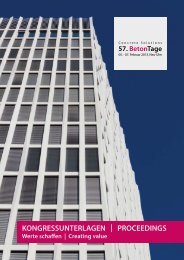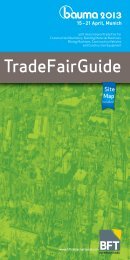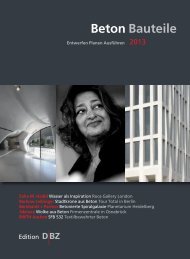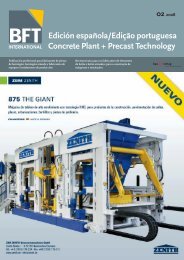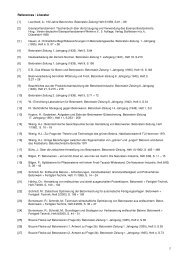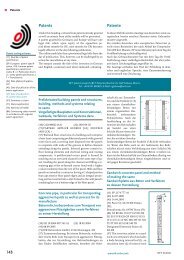Tagungsband - BFT International
Tagungsband - BFT International
Tagungsband - BFT International
Erfolgreiche ePaper selbst erstellen
Machen Sie aus Ihren PDF Publikationen ein blätterbares Flipbook mit unserer einzigartigen Google optimierten e-Paper Software.
PLENUM 2 // PROCEEDINGS<br />
� In most cases, precast components are the<br />
right choice for construction projects whene-<br />
ver certain underlying conditions need to be<br />
met. This relates to both the requirement of<br />
the shortest possible completion time and<br />
a high degree of repetition. At the planning<br />
stage, precast elements require a greater<br />
degree of detail in the design, and thus lon-<br />
ger lead times prior to actual construction<br />
work.<br />
C: SUSTAINABLE CONCRETE SOLUTIONS – PRECAST ELEMENTS<br />
FOR WIND POWER<br />
C: NACHHALTIGE LÖSUNGEN IN BETON – BETONFERTIGTEILE FÜR DIE<br />
WINDENERGIE<br />
Although the precast element presented in<br />
this contribution appears to be an extraordi-<br />
nary example, the above conditions are all met<br />
in an almost ideal scenario. To date, the ambi-<br />
tious climate policy targets of the German go-<br />
vernment resulted in the approval of almost<br />
5,400 wind turbines in 31 offshore wind parks<br />
Material: concrete //<br />
Material: Beton<br />
Weight: 6,000 tonnes //<br />
Masse 6.000 Tonnen<br />
Height: 65 m // Höhe: 65 m<br />
Base: 40x40 m //<br />
Basis: 40x40 m<br />
72 <strong>BFT</strong> 02/2011 www.bft-online.info<br />
� Betonfertigteile sind für eine Bauaufgabe meist<br />
dann die richtige Wahl, wenn bestimmte Rahmen-<br />
bedingungen zusammentreffen. Dies ist zum Einen<br />
die Erfordernis einer kurzen Ausführungszeit eines<br />
Projektes und zum Anderen eine möglichst hohe<br />
Wiederholungsrate. Betonfertigteile benötigen in<br />
der Planungsphase eine größere Planungstiefe und<br />
demzufolge mehr Zeit im Vorlauf vor der eigent-<br />
lichen Bauausführung.<br />
Obgleich es sich im vorliegenden Fall wohl um ein<br />
außergewöhnliches Betonfertigteil handelt, so sind<br />
doch die genannten Randbedingungen in geradezu<br />
idealer Weise erfüllt. Die ehrgeizigen klimapoli-<br />
tischen Ziele führten bislang dazu, dass allein in<br />
der deutschen Nord- und Ostsee knapp 5.400 Wind-<br />
kraftanlagen in 31 Offshore Windparks genehmigt<br />
worden sind und sich dieselbe Anzahl Windräder<br />
aktuell noch im Genehmigungsprozess befinden.<br />
Insgesamt sollen sich zukünftig also knapp 11.000<br />
Windräder in deutschen Gewässern drehen. Euro-<br />
paweit sind es etwa drei Mal so viele. Unter der<br />
Annahme, dass diese Windkraftanlagen alle im<br />
Rahmen des europäischen Konzeptes „Energie<br />
2050“ entstehen, sind pro Jahr über 800 Anlagen<br />
zu errichten. Tatsächlich gebaut wurden in Deutsch-<br />
land bislang 24 Offshore Windräder. Der derzeit am<br />
schnellsten wachsende Windpark in der Nordsee<br />
ist BARD I. Dort wurden seit April 2010 zwölf Wind-<br />
kraftanlagen errichtet (Stand Oktober 2010). Das<br />
sind knapp zwei Anlagen pro Monat – hochgerech-<br />
net also 24 Stück pro Jahr, wobei in den Wintermo-<br />
naten zum Teil nicht gebaut werden kann.<br />
Der Bau von 12 Anlagen im Windpark alpha ventus<br />
dauerte etwa neun Monate – in den Sommermo-<br />
naten ebenfalls mit zwei teilweise parallel arbei-<br />
tenden Installationseinheiten. Sowohl die Grün-<br />
dungslösung von BARD I (ein Stahl-Tripile) als auch<br />
von alpha ventus (Stahl-Jacket und Stahl-Tripod)<br />
haben vor allem eines gemeinsam: sie erfordern<br />
⊳ FIG. 1 Assembled turnkey wind turbine prior<br />
to sea transport; precast prestressed concrete<br />
foundation pad with steel tower, generator and<br />
rotor mounted on top. // ABB. 1 Schlüsselfertig<br />
montierte Windkraftanlage vor dem Seetransport;<br />
Spannbeton-Fertigteil-Fundament mit aufgesetztem<br />
Stahlturm, Generator und Rotor.<br />
in the German North Sea and the Baltic Sea<br />
alone whereas an identical number of turbines<br />
are currently going through the permit process.<br />
This means that a total of almost 11,000 wind<br />
turbines should be installed in German waters<br />
in the future. Across Europe, this figure is three<br />
times as high. Assuming that all of these wind<br />
turbines will be built as part of the European<br />
“Energy 2050” roadmap, over 800 units need<br />
to be erected each year. Only 24 offshore wind<br />
turbines have actually been built to date in<br />
Germany. The fastest-growing wind park in the<br />
North Sea is currently BARD I where twelve<br />
units have been installed since April 2010 (as<br />
of October 2010). This number is equivalent to<br />
nearly two units per month, i.e. 24 wind tur-<br />
bines per year. However, no construction acti-<br />
vity is possible during certain parts of the<br />
winter season.<br />
The erection of twelve turbines of the alpha<br />
ventus wind park lasted about nine months –<br />
with a partially simultaneous activity of two<br />
installation units during the summer months.<br />
The foundation design developed for BARD I<br />
(a steel tripile) and the alpha ventus solution<br />
(steel jacket and steel tripod) have one crucial<br />
feature in common: they require many indivi-<br />
dual work steps to be carried out at sea. Mo-<br />
reover, these activities can often not be perfor-<br />
med directly one after another, for example<br />
because mortar-grouted bond joints need to<br />
harden. In addition, each of the individual work<br />
steps requires favorable periods of several days<br />
during which very demanding specifications<br />
exist regarding the prevailing weather condi-<br />
tions (i.e. wind force and state of the sea).<br />
This means that either the required and/or<br />
available equipment may be used or the work<br />
itself be carried out only in the presence of<br />
significant wave heights smaller than 0.8 m.<br />
Such conditions prevail on only about 18% of<br />
all days of the year. If such conditions are re-<br />
quired even for three days in a row, the number<br />
of periods available per year is reduced to<br />
about 20.



